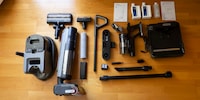

Vacuumed well, Miele Triflex HX1
For a long time, Miele watched what the competition was doing with cordless hoovers. Then, with its debut model, the Triflex HX1, it launched a versatile appliance on the market that pulls an incredible amount of hair out of carpets.
I'm slowly turning into a cleaning fiend. Being at home all the time also means watching the dust particles dance in the spring light before they settle on the crumb-covered floor. Until now, my iRobot Roomba has taken care of that. Now I've put it on short-time work because I don't want to spend hours watching it slowly circle the dirty areas. And my old corded vacuum cleaner is out of date. It blocks half the cleaning cupboard, creates a tripping hazard around the flat and occasionally loses a wheel. It's not a device that you can use to vacuum after the children ten times a day. We're living on a tight leash at the moment, so I at least want maximum freedom for the hoover. I've had the Miele Triflex HX1 for about a month now.

Three points spontaneously convinced me of this model:
- It doesn't look like a souped-up handheld hoover with an extended handle
- It doesn't look like a Dyson where the designers couldn't decide between a children's toy and a household appliance in terms of colour
- It looks like a rock-solid household appliance. As exciting as you would expect from a traditional German company.
Despite this, the Triflex wants to be more than just an ordinary hoover. Namely three hoovers. It can be converted in a few simple steps. There are also three variants that differ in the scope of delivery. A little customer confusion is a must. There is the Triflex HX1, the Triflex HX1 Cat&Dog (with light in the floor nozzle, an additional handbrush and HEPA Liftetime filter). In addition, the Triflex HX1 Pro, which is currently not available from us and which, in addition to the Cat&Dog equipment, also has a rechargeable battery with charging cradle included. I ordered the basic model.
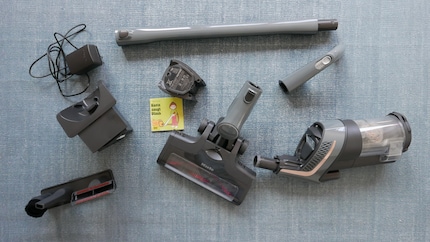
The suction power can be seen and heard
Since Miele has a reputation to lose and has not produced any cordless vacuum cleaners for a very long time, the Triflex can hardly afford any weaknesses. After all, the developers have had plenty of time to see what the competition is up to and which features are popular with customers. Unsurprisingly, suction power is at the top of the wish list for a hoover. And it is very good. Miele states that it is just as high as the most powerful corded model Complete C3.
I can't make this comparison, but the Triflex beats my old appliance hands down. It pulls dust out of joints and carpets that was previously safe from the 2400 watts of my Siemens corded vacuum cleaner. And above all, hair, hair, hair. I've never seen a better hair curler. Unfortunately, this also means that I have to remove it from the floor nozzle regularly. I know this from the Roomba, but not to this extent.
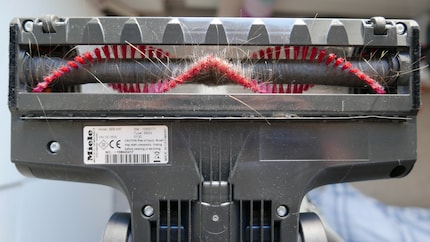
The brush roller has a guide groove that helps to cut hair and strands with scissors. The Triflex can then suck them up. The brush roller can be removed from the side for thorough cleaning. I am thoroughly impressed with the suction power. Especially because the appliance remains relatively quiet. The sonorous sound is still easy to listen to even at the highest setting.
The battery: Small, but replaceable
The supplied lithium-ion battery comes from Varta and is replaceable. That's how it should be. What's the point of a fixed battery on a hoover? It is simply stupid if such a crucial part cannot be changed without tools. If the Triflex runs out of power, you can plug in a replacement battery in two simple steps.
With 650 grams and 66 Wh, it is clear that the model installed in the Triflex is a compromise between weight and endurance. A closer look at the technical data reveals that the maximum runtime of 60 minutes on level one only applies to the "PowerUnit solo" - i.e. without the floor nozzle with electric brush. The main thing is to somehow crack the magic hour mark.
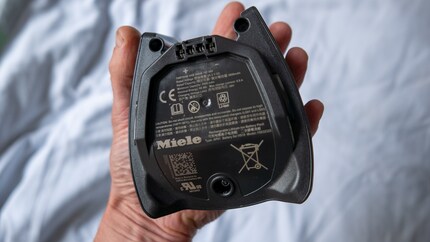
On the lowest setting, the vacuum runs out of air after 30 to 40 minutes on hard floors. At the medium and highest levels, a floor covering detection function is activated, which influences the power consumption and therefore also the service life. At full power, normal operation with the nozzle ends after around a quarter of an hour. However, you only need this in particularly dirty areas. One battery charge should be enough to clean a flat of 100 to 150 square metres properly. I can easily manage a good 100 square metres. Three LEDs provide only very rough information about the charge status. As soon as the last LED flashes, you should recharge. The charging socket is located on the battery. You can charge it directly on the vacuum cleaner, via the separately available charging cradle or simply with the cable supplied. It will be fully charged again in three to four hours.
Variant 1: The upright vacuum cleaner [[image:34984965]]
With the Triflex, you can choose whether you want to install the PowerUnit and dust container at the top of the handle or just above the floor, Dyson-style. It can be converted in a few simple steps. This is easy as long as you pull the connections straight. If you tilt it a little, the parts seem to be welded together.
I'm a fan of the variant with the centre of gravity just above the ground. This makes the Triflex extremely manoeuvrable, you hardly have any weight in your hand and the device can be parked vertically at any time. This is not only practical if you want the Triflex to be ready to hand in the living area just in case. It also takes up little space in the cleaning cupboard. For me, it's perfect 90 per cent of the time.
Variant 2: Dyson style
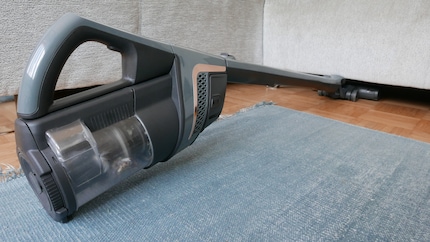
With the PowerUnit on top, the Triflex turns into a heavyweight. You then have most of its 3.64 kilos in your hand and complete a fitness programme while vacuuming. Our colleague Simon Balissat has already moaned about the Dyson V11 Absolute, which is a good 500 grams lighter. The HX1 from Miele manages the feat of being made entirely of plastic and still feeling very high-quality.
For me, there is hardly any reason to switch to the Dyson design. You can poke around between chair legs and vacuum under the bed a little better, but there's not much difference. The Triflex can't be made really flat, the dust container is in the way. For me, the conversion is only worthwhile for vacuuming cobwebs from the ceiling or keeping things clean behind the sofa.
Variant 3: The powerful vacuum
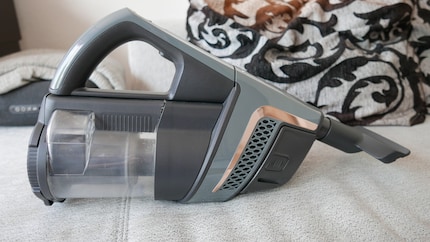
If you leave out the suction pipe, you're left with a knobbly handheld device. Then the Triflex cuts a funny figure. While normal handheld hoovers are as slim as bees, it is a bumblebee. Likeable, but only useful in special cases. It's fine for vacuuming large areas of upholstery. But too clunky to get to all the dirty places in the car. The somewhat short crevice nozzle is also not helpful. If you have steep stairs to vacuum, you might learn to love this short configuration in combination with the floor nozzle. Not me.
The dust container: Small, but finely filtered
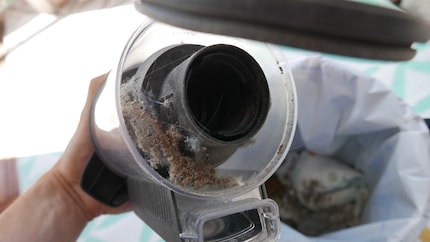
The transparent plastic container has space for 500 ml of dirt. This comes together quickly and gives me the opportunity to practise emptying and cleaning. To separate the dust container from the vacuum cleaner, just twist the lid. It can then be removed. This is practical, as it makes it easy to move the mess outside without having to lug the whole appliance around.
An additional twist of the lid of the dust container, which is only possible after removing it, opens the lower flap and the dirt trickles out. At least in theory. In practice, I occasionally have to poke around in it to loosen lumps. Even inside, unruly hair ensures that everything gets stuck. And the dust trapped by the pre-filter, fine dust filter and motor protection filter still makes contact with my bronchial tubes when I knock it out. I should probably wear an FFP2 mask. At least when thoroughly cleaning the filters.
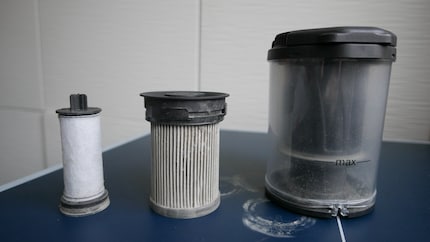
The fine dust filter is difficult to pull out, but should be carefully tapped at least once a month. When it is removed, it reveals the motor filter, which can also be unscrewed and removed. The motor filter does not require any special care, but is in the way if you want to reach the pre-filter to brush it off.
Where there is filtering, there is some work involved. The effort is justifiable and the idea of the removable dust container is good, but the crucial points are not easy to reach. I prefer to empty it sooner rather than later. The fuller it is, the more likely it is to get blocked.
The accessories: Why a wall bracket?
Strictly speaking, the large "Multi Floor XXL electric brush" is not an accessory, but part of the basic equipment. Nevertheless, I want to say a few words about it because it does a very good job as an "everyday nozzle". At 28 centimetres, it is wide enough to vacuum quickly around the home. Its relatively hard bristles could only cause damage on extremely scratch-sensitive surfaces. I have no problems with it on carpet, tiles and parquet and don't miss the LED lighting. It is also a solid base for the Triflex. It just doesn't get the last centimetre at the edges clean.
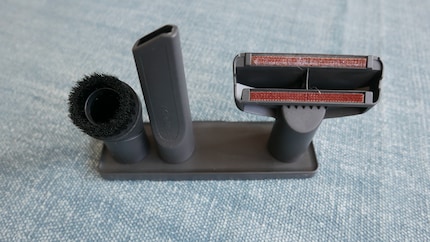
In addition, an upholstery nozzle, a short crevice nozzle and a suction brush are included, which have their regular place on a plastic holder and are not particularly worth mentioning on their own. Combined with the convertible vacuum cleaner, they nevertheless offer a wide range of possibilities. For me, the wall bracket is completely superfluous. My vacuum cleaner is stable even without it. And always where I want it. That's why I don't feel the need to sink two plugs into the wall, screw on the plastic part and thread in the charger. If you make the effort, you have to decide on a height and therefore a specific configuration. I prefer to remain flexible - because that's the Triflex's strength.
Conclusion: A strong debut
The Triflex HX1 is reduced to the essentials. It looks appealing without enticing with fancy colour combinations or superfluous displays. In return, it sucks up powerfully, is pleasantly quiet and versatile. I like the heavy quality, despite the plastic, everything apart from the standard accessories looks very high quality.
The connections engage cleanly, the three-stage slide switch does what it should and the battery is easy to replace. The runtime is not outstanding, but it is completely sufficient for my needs. For me, the vacuum cleaner scores points in everyday use mainly because it can be set up vertically and is always ready to hand. On the other hand, it has weaknesses when used horizontally. Even with the PowerUnit attached to the top, it cannot be flattened properly.
The detachable dust container is a good idea, but is prone to blockages. It fills up quickly, especially when vacuuming carpets. The Miele's speciality is long hair, which it devours en masse with its robust brush roller. It then requires some maintenance and is occasionally difficult to empty. Overall, Miele's cordless vacuum cleaner does a great job. If you don't mind the few shortcomings, I can recommend the Triflex HX1.
Simple writer and dad of two who likes to be on the move, wading through everyday family life. Juggling several balls, I'll occasionally drop one. It could be a ball, or a remark. Or both.
